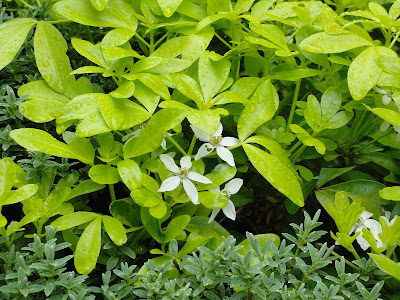Sadly I will not be posting the lyrics to Me Ol' Bamboo from Chitty Chitty Bang Bang for you, although I'd like to think the song is in your head now.
I had a lady ask me a couple of weeks ago if I knew anything
about bamboo and how to maintain it and whether or not it should be cut down to
the ground every year. So I thought that this blog was the perfect place to
tell you all about the general maintenance requirements of this plant. Should
you yourself have any questions about other plants then please feel free to
leave me a message and I will create a profile about that plant for you to see
on here.
Bamboo plants are very desirable as they are used as focal
points or for adding structure to a border. They are classed as either running
or clump-forming. Running ones are more commonly known as invasive bamboos as
these create long rhizomes which grow away from the main plant and grow rampantly
if not contained. Clump-forming bamboos are as the name suggests ones that grow
in tight clumps and are less invasive. There are various types of bamboo and they
can work in nearly every garden situation.
When you have picked out your particular variety then plant
it in the spring to allow the plant to produce a good amount of canes for the
summer. You should ensure that you water the plant regularly during dry periods
and apply a balanced fertiliser to ensure it has the best chance of surviving. To try and make sure your bamboo doesn’t overrun the rest of your garden it can be beneficial to create a barrier around the base by digging a trench at least 60cm deep, and lining it with solid materials such as paving slabs or root barrier fabric which overlap each other. The barrier should protrude from the soil by about 7.5cm to stop the bamboo stems from arching over the top and spreading further. To stop unwanted growth within your garden you would need to cut off the underground rhizomes from the parent plant and cut the canes of that section to the ground. It is recommended that you then use a stump and root killer but that would depend on how you felt about using chemicals in your garden. Another way to ensure it does not overrun your garden is to keep it in a container. Bamboos do make a good focal point when kept in a patio container. This would require frequent watering and a liquid feed to ensure the plant receives all the nutrients it needs.
When it comes to general maintenance, in spring remove any dead, weak or damaged canes by cutting them to ground level and remove any debris from around the base. To create a more aesthetically pleasing look then remove some of the foliage from the base of the canes to create a smooth finish.
Should your bamboo start to flower, then cut out that particular shoot as this can weaken the plant. But if the whole plant starts to flower then allow it to occur. The bamboo will look unattractive but continue to feed and water it. Then in the spring, cut the bamboo down to ground level and feed with a nitrogen fertiliser which will encourage new growth.
If you wish to propagate then divide the plant in mid-spring. Rhizome cuttings can be taken in early spring by choosing 1-2 one year old canes and cut the rhizomes away from the plant. Cut the canes down to 30cm and place horizontally in a tray of gritty compost and lightly cover. Water the cuttings and keep in a warm place, then plant out in the following spring when the chance of frost has passed.
So to answer the original question that was posed, then no the bamboo canes do not need to be cut down every year unless there are the odd flowering shoots.














